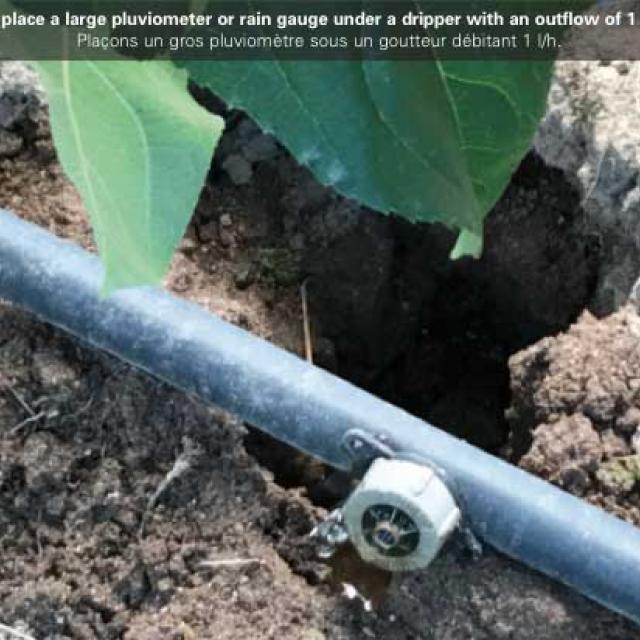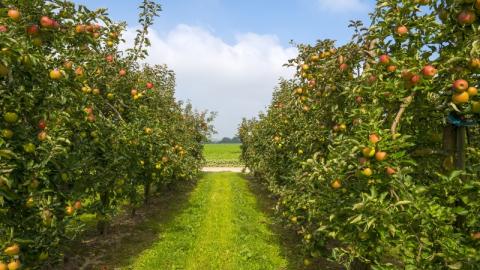Drip irrigation is a very efficient technique. Less force required by the plants to extract the water from the soil, i.e. lower soil water tension in the wetted zone, known as a bulb. This localised application technique allows for a significant reduction in the volume of water required per unit of production, expressed, for example, in m3 of water per kg of production (yield).

With a high degree of technical complexity and using a logic that differs from sprinkling, this method needs to be managed precisely. We will, therefore, discuss here a few of the basic principles, methods and observations without going in to any theoretical calculations.
The complex notion of the units of measurement
We placed a large pluviometer or rain gauge under a dripper with an outflow of 1 l/h. The aperture area of the collecting surface is a disc measuring 400 cm2, close to the part of the wetted bulb available to the plant, which measures some twenty or so cm in diameter, this being typical of market garden crops.
At the end of an hour of irrigation, the rain gauge collected 1 L, thus recording 25 mm of precipitation.
This demonstrates that a single irrigation of 1 litre applied by the drip method represents an important event for the soil.
At the dripper’s point of emission, which is the size of a coin, the precipitation or application depth at each irrigation can be 100 times greater, i.e. 2500 mm.
This means that the soil should absorb, by means of irrigation at the precise spot, several years of natural rainfall. The soil does all the work. Everything take place in the soil.
After looking at tens of thousands of cases, we can observe that the optimum volume of water that would allow for the water content of the wetted bulb to be agronomically effective, while preserving the structure of the soil, varies, depending on the crop, soil type and climate, between 0.5 and 3 L per dripper and per unit of irrigation. The exception would be the amounts applied voluntarily at certain specific growing stages, on crops with deep rooting systems, such as the grape vine or asparagus.
A reminder of the significance of the ‘mm’ in irrigation
The mm is a linear unit of measurement, representing depth in this instance, expressed in a single dimension whereas a surface area is 2-dimensional and volume is 3-dimensional.
For example, 1 mm of water applied to 1 m2 represents 1 L.
As far as rainfall is concerned, a depth of 1 mm of water applied over 10,000 m2 (1 ha) represents a volume of 10,000 l or 10 m3/ha.
In such a situation, this will be demonstrated by the rain gauge, which takes a sample of the rainfall, supposedly evenly, via its funnel collector measuring 1⁄25th of a m2 (400 cm²).
With regard to sprinkler irrigation, which, broadly-speaking, covers the whole of this hectare, an application of 1 mm will always be 10 m3/ha and it can always be measured by the rain gauge, even if the layout of the sprinklers makes the operation more complicated than it seems.
If we look at localised irrigation, then, by definition, only a part of the surface area and soil volume is irrigated.
With micro-sprinkling, the surface area in question varies between 20 and 100%, depending on the number of micro or mini sprinklers and their range. The significance of the reference surface area is lost if it is not calculated. The rain gauge can be used, however, but this would be subject to strict conditions vis-à-vis the reference surface area. Its relevance depends on the positioning and distance of the sprinkler.
On the other hand, 2000 drippers applying water to 1 ha of trees, for example, occupy around 15% of the soil volume.
That does not pose a problem as far as performance is concerned, but it does change the rationale.
We lose the usage and significance of the rain gauge and its mm, which imperatively need a reference surface area if it is to mean anything.
This is certainly where this misunderstanding arises with regard to localised irrigation, with the devil himself hiding in the drip system.
This confusion relates to the calculations, transpositions that are not verified by the field observations, which leads to under-performance, and the notorious over-irrigation, as confirmed in the field in very significant proportions.
The volume of the wetted bulb in 3 dimensions
The concept of volume applies to everything related to water, the hydraulics, the soil and the bulb.
The measuring unit ‘m3’ or ‘m3/h’ applies to everything related to pumping, the hydraulic or water system.
The measuring unit ‘the litre’ or ‘l/h’ is used for everything related to the dripper and the bulb.
Observations and advice relating to 4D
Basic norms. Our thirty years’ experience of using tensiometer readings for drip irrigation has confirmed that measurements have to be taken for a number of bulbs; at least 3 for the scheduling and 4 for the automation. It is not a matter of selecting 3 drippers, checked and compliant, out of 3000 or 5000 drippers, but rather using common sense. In fact, 1 measuring point is always going to be correct by definition; 2 measurements can differ; taking 3 measurements allows for a median value to be extracted.
The representation or image in terms of volume begins AT 2 depths and 2 distances from the drippers, with a minimum of 3 repeats.
The more sensors there are placed
3-dimensionally in relation to the dripper the clearer will be the image of the bulb.
This can be seen with the potential of the ultrasound imaging of the bulb, which is based on the readings of 16 sensors and 3 bulbs.
The 4D
The 4th dimension is time. We can observe how this bulb, formed in the soil and monitored as a 3D model, changes over time.
4D is, therefore, naturally very suitable for the precise agronomic guidance required for managing the volume of the bulb and the amounts of irrigation water applied. Understanding the fourth dimension: the indispensable notion of time or dividing up the time.
For example: the following week, on this plot or group of plots, irrigate every day: 3 times, 1.6 L per dripper.
To complement the device, a volume meter for controlling the tertiary water supply system allows the irrigation system to be monitored in real time. Good coherence and consistency in the volumes measured vis-à-vis the nominal value calculated for the system. Detecting a drop in volume (clogging, leakage), an increase (excessive pressure), a significant increase (problems with the solenoid valve or the programming) or a lack of volume (breakdown).
Programming advice
The core principle of scheduling is being able to make a decision on a weekly basis: even programming (the irrigation) for the following week or changing the programme.
Without a controller, drip irrigation is very tedious, annoyingly complex and very simplistic as far as the dividing-up procedure is concerned.
In order to allow the amounts applied to be adapted to the functioning of the soil, so as to maintain an optimum bulb, then the scheduled irrigation must be divided up into several applications. This is provided by a controller set to a minimum of 4 irrigation starts per day, per zone, in an oceanic, continental and Mediterranean-type climate in the northern hemisphere. Certain rooting /soil /climatic conditions require up to 6 irrigation starts per day.
The decision-making support, in its most developed form, therefore, targets the programming, summarised in 1 dimension: time or planning.
Subject to scheduling and monitoring, it can be used safely.
In the same example: the following week, on this plot or group of similar plots, irrigate every day: 3 x 1 hour

